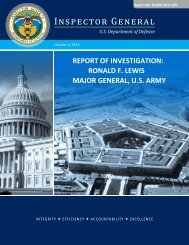Command Red Team
2gWzzvB
2gWzzvB
You also want an ePaper? Increase the reach of your titles
YUMPU automatically turns print PDFs into web optimized ePapers that Google loves.
Introduction to the <strong>Command</strong> <strong>Red</strong> <strong>Team</strong><br />
(1) Plans and Operations. The command red team supports crisis action<br />
planning (CAP), deliberate planning, and operations assessment by helping identify<br />
vulnerabilities, opportunities, and faulty or unstated assumptions; helping ensure all<br />
aspects of the operational environment (OE) are fully understood; and critically<br />
reviewing strategies, operational concepts, estimates, plans, and orders. <strong>Red</strong> team<br />
products can also include wild card or low probability/high impact analysis to anticipate<br />
surprise and to mitigate risk.<br />
(2) Intelligence. The command red team complements intelligence efforts by<br />
offering independent, alternative assessments, and differing interpretations of<br />
information. This includes critical reviews of intelligence products, considering problem<br />
sets from alternative or adversarial perspectives, and helping contribute informed<br />
speculation when reliable information is lacking.<br />
g. In practice, command red team operations are categorized into four broad<br />
overlapping and mutually supporting areas of effort. When addressing a particular<br />
problem, red teams will usually pursue multiple areas of effort simultaneously. Directly<br />
or indirectly, all command red teams provide decision support, regardless of their primary<br />
focus.<br />
(1) Decision support promotes consideration of alternatives; challenges<br />
assumptions; stimulates critical and creative thinking; helps minimize biases,<br />
organizational influences, and analytical error; and provides alternative and cultural<br />
perspectives.<br />
(2) Critical review provides independent, alternative assessments of problem<br />
sets; critically reviews estimates, assessments, and interpretations; explores unseen<br />
threats and opportunities; and estimates the effects of potential wild card events. These<br />
effects can be categorized as unintended and intended and analyzed to determine varying<br />
degrees of those effects, such as second, third, or fourth order.<br />
Key Terms<br />
Second and Third Order Effects. A cascading series of multiple<br />
effects, anticipated and unanticipated, intended and unintended, with<br />
potentially significant positive and/or negative impacts on the<br />
operational environment, that result from an action. These effects then<br />
become the causes of new effects.<br />
Wildcard Events. Unanticipated circumstances, not necessarily related<br />
to planned actions or occurring within the operations area, that<br />
complicate execution of the plan.<br />
Critical Review. An independent examination of a product by a<br />
disinterested party with the object of uncovering logical fallacies,<br />
biases, and evidential shortfalls, or evaluating a wider range of<br />
potential conclusions.<br />
I-3



